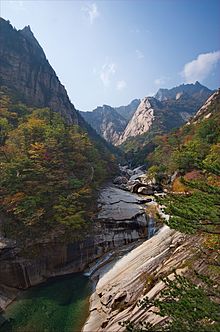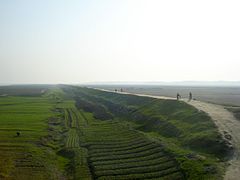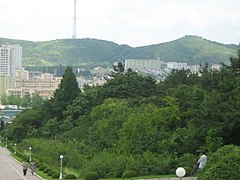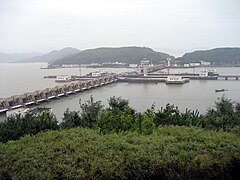
The environment of North Korea comprises the diverse ecosystems of the part of the Korean peninsula controlled by the Democratic People's Republic of Korea. This includes alpine, forest, farmland, freshwater, and marine ecosystems.
Since the 1980s, the environment has been reported to be in a state of "crisis", "catastrophe", or "collapse". Pollution and deforestation are key problems. However, this has been contested by some accounts. In addition, North Korea has some environmental programs to mitigate the problems.
Overview
More than 80 percent of North Korea is mountainous with cultivation largely confined to coastal strips in the east and west. According to a United Nations Environmental Programme report in 2003, forest covers over 70 percent of the country, mostly on steep slopes. However, other studies have suggested that, due to deforestation, forest cover was only about 50%. There are nine rivers and numerous smaller waterways. The environment is correspondingly diverse, consisting of alpine, forest, farmland, freshwater, and marine ecosystems.
Due to its geological history, the country has a range of vegetation, from the subtropical, temperate and frigid zones, which are able to coexist due to the combined effects of oceanic and continental climates. The climate has pronounced seasonal variations, with warm summers and snowfall in winter.
Biodiversity
Further information: List of mammals of North Korea and List of birds of North KoreaIn 2003, animal and plant species in North Korea were reported to be "profuse". Four percent of the higher plant species were reported to be endangered, vulnerable, rare, or in decline. Eleven percent of vertebrate species were reported to be critically endangered, endangered, or rare.
In 2013 a delegation of visiting scientists reported major environmental devastation. They described an absence of wildlife and said that the "landscape is basically dead". This situation was described as "so severe it could destabilize the whole country".
However, a group of birdwatchers from the Pukorokoro Miranda Naturalists' Trust, New Zealand, visited the Yellow Sea shore of Mundŏk County in South P'yŏngan province in 2016 and reported that the mudflats there were a haven for bird life. The relative lack of development there compared to nearby China and South Korea had provided a refuge for several internationally important birds on their migration along the East Asian-Australasian Flyway - such as the critically endangered eastern curlew, the Eurasian curlew and the bar-tailed godwit.
Flora
Main article: Flora of North KoreaThe flora of North Korea has much in common with that of other areas of the Northern Hemisphere. 2898 species have been recorded, of which 14% are endemic. Four are classified as threatened.
The native plant communities in the lowlands have largely disappeared with cultivation and urbanisation. Native conifer forest communities are located in the highlands. The forest types are mainly subarctic (boreal) and cool-temperate forest.
Environmental issues

Pollution
Main article: Pollution in North KoreaIn 2003, air pollution in Pyongyang, largely due to combustion of coal, was reported to be unacceptable. This is somewhat mitigated by the high use of public transport in urban areas.
In 2003, the pollution of rivers and streams was reported to be "severe" due to a decrease in investment in environmental protection and the improper discharge of untreated sewage and industrial effluent. The quality of the Taedong River, which flows through Pyongyang, was reported to be "deteoriating", exacerbated by the construction of the West Sea Barrage. A survey conducted in 2017 found that 93% of sanitation facilities were not connected to a sewage system. Rather, the human waste was used as fertilizer on fields, creating the potential health risk of spreading intestinal worms.
North Korea produces large quantities of DDT and other pesticides.
Deforestation
Cultivation, logging, and natural disasters have all put pressure on North Korea's forests. During the economic crisis of the 1990s, deforestation accelerated, as people turned to the woodlands to provide firewood and food. This in turn has led to soil erosion, soil depletion, and increased risk of flooding.
Based on satellite imagery in 2013, it has been estimated that 40 percent of forest cover has been lost since 1985. The United Nations Environmental Programme in 2003 reported a much smaller rate of depletion.
A forest restoration policy has been in place since 2012, especially on hillsides around Pyongyang and in South Pyongan Province. However deforestation appears to continue in remote areas. New crop cultivation of slopes exceeding 15 degrees has been banned to help prevent erosion and landslides.
In 2018, North Korea had a Forest Landscape Integrity Index mean score of 8.02/10, ranking it 28th globally out of 172 countries. Satellite analysis of North Korean land in 2019 indicated forests accounted for 45%, farmland for 27% and grasslands for 13%.
In recent years, forest cover has been growing at 0.2% every year up to 45% in 2019, with forests reemerging especially around Pyongyang, although in some rural areas, deforestation has still occurred, due to wood being an easy source of fuel in the countryside.
Climate change
This section is an excerpt from Climate change in North Korea.
North Korea is highly vulnerable to the effects of climate change due to its weak food security, which in the past has led to widespread famine. The North Korean Ministry of Land and Environmental Protection estimates that North Korea's average temperature rose by 1.9 °C between 1918 and 2000. In the 2013 edition of Germanwatch's Climate Risk Index, North Korea was judged to be the seventh hardest hit by climate-related extreme weather events of 179 nations during the period 1992–2011.
North Korean carbon dioxide emissions are estimated to be roughly 56.38 million metric tons of CO2 in 2021. The vast majority of this is due to North Korea's reliance on coal for energy production. As a result of its mountainous geography as well as the onset of sea level rise and increasing frequency of extreme weather events, the biggest climate change-related concern for North Korea is food security. Low food production in 2017 and 2018 resulted in undernourishment in an estimated 10.3 million people. This has created a high dependency on foreign nations to fulfil food demands. This challenge - along with disruption to economic growth as a result of climate change - might undermine the totalitarian rule of the North Korean government and may be a cause for regime change in the future.Environmental programs
In response to the deforestation problem, North Korea has implemented a tree planting program. In 2016, the Korean Central News Agency reported that the Central Nursery under the Ministry of Land and Environment Protection had produced 90 million saplings over the past five years for distribution around the country. Official pronouncements have labeled illegal forest destruction as "treachery" and threatened perpetrators with the death penalty. In 2017, Kim Il-sung University announced the opening of a new Forest Science Department. In 2018, North Korea made an agreement with the South on forestry co-operation.
The North Korean government has ratified the Kyoto Protocol on global warming and has been co-operating with international efforts to combat climate change. It has invested in the development of solar and other renewable energy technology. In 2017, the Foreign Ministry condemned the US government for withdrawing from the Paris Agreement.
North Korea has participated in international environmental projects, such as the conservation of the red-crowned crane. In 2017, Pyongyang hosted a workshop on the conservation of wetlands and migratory waterbirds, attended by the International Union for Conservation of Nature, the Hanns Seidel Foundation, and the East Asian Australasian Flyway Partnership.
While recycling of materials in North Korea has always been a practice, a new law in 2020 gave it a much higher profile and required organizations to recycle. A national recycling plan stipulated the minimum recycling quantity for certain materials, and placed requirements at the province, county and city levels. Economic reasons are a strong driver of this effort, reducing some imports.
Gallery
-
 A North Korean agricultural landscape
A North Korean agricultural landscape
-
 Myohyang Mountain
Myohyang Mountain
-
 North Korean countryside
North Korean countryside
-
 Forested slopes around Kaesong
Forested slopes around Kaesong
-
Mountains in North Korea
-
 North Korean river
North Korean river
-
 Hwanghae Province scenery
Hwanghae Province scenery
-
 Yalu River Delta
Yalu River Delta
-
 North Korean coastline
North Korean coastline
-
 West Sea Barrage
West Sea Barrage
See also
References
- ^ Tenenbaum, David J. (2005). "International Health: North Korean Catastrophe". Environ Health Perspect. 113 (1): A26. doi:10.1289/ehp.113-a26. PMC 1253723. PMID 15643724.
- ^ McKenna, Phil (6 March 2013). "Inside North Korea's Environmental Collapse". PBS.
- ^ Kirby, Alex (27 August 2004). "North Korea's environment crisis". BBC.
- United Nations Environmental Programme. "DPR Korea: State of the Environment, 2003" (PDF). p. 53. Archived from the original (PDF) on 1 September 2004.
- United Nations Environmental Programme. "DPR Korea: State of the Environment, 2003" (PDF). p. 12. Archived from the original (PDF) on 1 September 2004.
- ^ Hayes, Peter (12 October 2009). "Unbearable Legacies: The Politics of Environmental Degradation in North Korea". Asia Pacific Journal: Japan Focus.
- United Nations Environmental Programme. "DPR Korea: State of the Environment, 2003" (PDF). p. 30. Archived from the original (PDF) on 1 September 2004.
- United Nations Environmental Programme. "DPR Korea: State of the Environment, 2003" (PDF). pp. 13, 52. Archived from the original (PDF) on 1 September 2004.
- United Nations Environmental Programme. "DPR Korea: State of the Environment, 2003" (PDF). p. 12. Archived from the original (PDF) on 1 September 2004.
- United Nations Environmental Programme. "DPR Korea: State of the Environment, 2003" (PDF). p. 11. Archived from the original (PDF) on 1 September 2004.
- United Nations Environmental Programme. "DPR Korea: State of the Environment, 2003" (PDF). p. 53. Archived from the original (PDF) on 1 September 2004.
- "Why North Korea is a safe haven for birds". BBC News. 20 June 2016. Retrieved 20 June 2016.
- Haggett, Peter (2001). Encyclopedia of World Geography. Marshall Cavendish. p. 3088. ISBN 0761472894.
- Jirí Kolbek; Ivan Jarolímek; Milan Valachovic (2003). "8: Forest Vegetation of the Northern Korean Peninsula". In Jirí Kolbek; Miroslav Šrůtek (eds.). Forest Vegetation of Northeast Asia. Springer. pp. 264, 294. ISBN 1402013701.
- United Nations Environmental Programme. "DPR Korea: State of the Environment, 2003" (PDF). pp. 37–38. Archived from the original (PDF) on 1 September 2004.
- United Nations Environmental Programme. "DPR Korea: State of the Environment, 2003" (PDF). p. 43. Archived from the original (PDF) on 1 September 2004.
- United Nations Environmental Programme. "DPR Korea: State of the Environment, 2003" (PDF). p. 29. Archived from the original (PDF) on 1 September 2004.
- Miles, Tom (21 June 2018). "Tackling North Korea's chronically poor sewage 'not rocket science': U.N." Reuters.
- "The Environment Is So Bad in North Korea, They'll Even Let Americans Help". The Atlantic Wire. 3 April 2012. Archived from the original on 6 June 2013. Retrieved 10 June 2013.
- Raven, Peter (9 September 2013). "Engaging North Korea through Biodiversity Protection". Science & Diplomacy. 2 (3).
- United Nations Environmental Programme. "DPR Korea: State of the Environment, 2003" (PDF). pp. 25–27. Archived from the original (PDF) on 1 September 2004.
- ^ Bruce Songhak Chung (31 December 2020). "North Korean Forestlands Have Rebounded in Recent Years". 38 North. The Henry L. Stimson Center. Retrieved 6 January 2021.
- Grantham, H. S.; Duncan, A.; Evans, T. D.; Jones, K. R.; Beyer, H. L.; Schuster, R.; Walston, J.; Ray, J. C.; Robinson, J. G.; Callow, M.; Clements, T.; Costa, H. M.; DeGemmis, A.; Elsen, P. R.; Ervin, J.; Franco, P.; Goldman, E.; Goetz, S.; Hansen, A.; Hofsvang, E.; Jantz, P.; Jupiter, S.; Kang, A.; Langhammer, P.; Laurance, W. F.; Lieberman, S.; Linkie, M.; Malhi, Y.; Maxwell, S.; Mendez, M.; Mittermeier, R.; Murray, N. J.; Possingham, H.; Radachowsky, J.; Saatchi, S.; Samper, C.; Silverman, J.; Shapiro, A.; Strassburg, B.; Stevens, T.; Stokes, E.; Taylor, R.; Tear, T.; Tizard, R.; Venter, O.; Visconti, P.; Wang, S.; Watson, J. E. M. (2020). "Anthropogenic modification of forests means only 40% of remaining forests have high ecosystem integrity - Supplementary Material". Nature Communications. 11 (1): 5978. doi:10.1038/s41467-020-19493-3. ISSN 2041-1723. PMC 7723057. PMID 33293507.
- Eunjee, Kim (23 November 2015). "Experts: N. Korea Especially Vulnerable to Effects of Climate Change". Voa News. Voice of America. Retrieved 26 October 2020.
- Ministry of Land and Environment Protection (2012). Democratic People's Republic of Korea Environment and Climate Change Outlook (Report). Ministry of Land and Environment Protection. p. 75. ISBN 978-9946-1-0170-5. Retrieved 26 October 2020.
- Harmeling, Sven; Eckstein, David (November 2012). Baum, Daniela; Kier, Gerold (eds.). Global Climate Risk Index 2013 (PDF) (Report). Germanwatch e.V. ISBN 978-3-943704-04-4.
- Ritchie, Hannah; Roser, Max. "North Korea - CO2 and Greenhouse Gas Emissions". Our World in Data. Retrieved 28 May 2023.
- Pavone, Gregory; Sun, Jin (March 2014). Coal diplomacy: the political economy of North Korean coal (PDF) (Report). Harvard University. p. IV. Archived from the original (PDF) on 8 November 2021. Retrieved 12 March 2021.
- International Federation of Red Cross And Red Crescent Societies (29 April 2019). DPR Korea: Drought and Food Insecurity - Information bulletin (Report). IFRC.
- Habib, Benjamin (2010). "Climate Change and Regime Perpetuation in North Korea". Asian Survey. 50 (2): 396–400. doi:10.1525/as.2010.50.2.378.
- "North Korean Cabinet Adopts Forest Restoration Resolution". The Institute of Far Eastern Studies. 15 March 2015. Retrieved 18 April 2015.
- United Nations Environmental Programme. "DPR Korea: State of the Environment, 2003" (PDF). pp. 25–27. Archived from the original (PDF) on 1 September 2004.
- "90 Millions of Saplings Produced at Central Nursery". Korean Central News Agency. 16 December 2016.
- Dagyum Ji (15 November 2016). "Exclusive: N.Korean warning threatens deforesters with execution". NK News.
- JH Ahn (27 March 2017). "Pyongyang's Kim Il Sung University opens new "forest science" department". NK News.
- Dagyum Ji (4 July 2016). "Two Koreas agree to joint action on forest cooperation, pest control". NK News.
- Habib, Benjamin (20 May 2014). "North Korea: an unlikely champion in the fight against climate change". The Guardian.
- Byrne, Leo (11 August 2016). "North Korea holds solar, renewable tech exhibition". NK News.
- Griffiths, James (7 June 2017). "North Korea accuses Trump of being 'selfish' over Paris climate pact". CNN.
- Wagner, Eric (April 2011). "The DMZ's Thriving Resident: The Crane". The Smithsonian Magazine.
- "National Workshop held in Pyongyang, North Korea". East Asian Australasian Flyway Partnership. 17 June 2017.
- Williams, Martyn (15 June 2021). "Turning Waste into Treasure: North Korea's Recycling Push". 38 North. The Henry L. Stimson Center. Retrieved 18 June 2021.
External links
 Media related to Nature of North Korea at Wikimedia Commons
Media related to Nature of North Korea at Wikimedia Commons